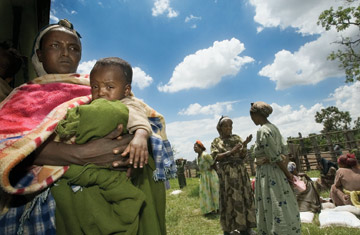
FACING THE FUTURE: Medina Genedo with her daughter Hamdiya Aman. Hamdiya is 2 years old, but poor nutrition has hindered her growth. Half of all Ethiopian children suffer from malnutrition
Once in a while, we kids growing up in a Washington suburb would try to save the world. Our idealism often took the form of a "can drive" in which we would rescue dusty tins from the back of kitchen cupboards to feed the hungry. I don't recall where the cans went exactly, but world starvation had a very specific face for us: a wide-eyed, big-bellied, fly-covered Ethiopian. Even in our American bubble, we knew that the 1984-85 famine had killed some 1 million Ethiopians. We would do our part by sending them cans of cream of mushroom soup, gefilte fish and Hormel Chili. I never once wondered whether the average Ethiopian owned a can opener.
The Ethiopians waiting for their food rations in the Meskan District of the arid Great Rift Valley look just as I'd imagined: wide-eyed and covered in flies. Many of the children are big-bellied from malnutrition. But the sustenance they receive from the United Nations World Food Programme (WFP), which coordinates roughly half of global food aid, are not cans of Campbell's soup but E.U.- and U.S.- donated sacks of grain and tubs of refined vegetable oil. The two are mixed together to form a nutritious blend designed to bolster childrens' diets in a country where half the children are malnourished. Medina Genedo's daughter is 2 years old but looks half that age, a listless lump taking shallow breaths under her mother's shawl. Two people have already died of hunger in the past few months in Genedo's village, whose crops are often destroyed by baboons. "I want to thank America for this food," she says, holding rations emblazoned with the stars and stripes. "Without it, I worry my daughter will not survive."
Food aid feels good. My classmates understood its visceral satisfaction, as do farmers in Iowa whose corn is used to nourish starving Africans. Last year, WFP coordinated emergency food aid for 73 million people worldwide, with the U.S. contributing 60% of that total. Yet this donated bounty may not be the panacea we imagine. A January report by the U.N.'s Food and Agricultural Organization (FAO) put the question bluntly: Can food aid do more harm than good? "There's no question that food aid saves millions of lives," says FAO senior economist and report editor Terri Raney. "But we're concerned that it's being asked to do too much, too inefficiently, and that by over-relying on food aid we ignore other solutions that could be more effective."
Nearly a quarter-century after the famine that prompted Live Aid, Ethiopia is still a desperately hungry place. It receives more food aid than any other nation save Sudan. "Other countries like India have graduated from food dependency and are now food donors, so it's fair to ask why Ethiopia is still so food dependent," says Paulette Jones, spokesperson for WFP in Ethiopia. "But when you see a hungry child, it's very hard to say, no, we're not going to give any more."
Still, in a country like Ethiopia, where corruption and tribal tensions are rife, how much food aid actually reaches the neediest? International agencies and donor governments try to monitor the thousands of tons of grain flowing in, and millions of Ethiopians survive thanks to foreign charity. But last year, usaid, the American government arm that coordinates emergency food aid, had just 23 staff members monitoring $1.7 billion in food programs across 55 countries. "I've been to places where starving villagers say they have never received food aid, but then you go to the village chief's house and you see bags of foreign grain stacked up," says the director of a Western aid agency operating in Ethiopia. "In too many cases, we're allowing food aid to strengthen a corrupt politician's power."
Even more troubling is how much money is wasted getting provisions to people like Genedo and her daughter. One-third of food-aid budgets, or roughly $600 million, never reaches the intended recipients and is instead swallowed up by costs in donor countries, according to the oecd. That's because only 15% of donated food is sourced locally, even though plentiful grains may be harvested just over the mountain from famine-stricken areas. Almost all U.S. food aid, by law, must be grown and processed at home. U.S. agribusiness, which receives subsidies for growing such crops, and the U.S. shipping industry profit from the arrangement. But transporting California rice to a rice-growing country like Cambodia makes little sense. When the food finally arrives — often too late to feed those most vulnerable — the influx of foreign products can wreak havoc on the local market, depressing prices just when farmers need income to feed themselves. As an alternative, economists like Nobel laureate Amartya Sen suggest rich countries send cash, which in many cases may flow into needy economies more quickly and efficiently than food aid.
Some donor nations have changed course. Canada now focuses either on funding locally grown crops or arranging direct cash transfers to vulnerable populations. The European Union has also shifted to regional sourcing; less than 10% of its food-aid budget is now reserved for food grown back home.